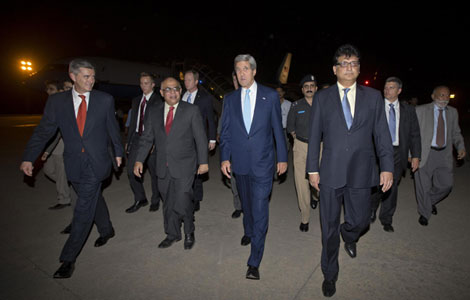Focus on urbanization, Shanghai FTA
Updated: 2013-08-01 13:34
(China Daily)
|
|||||||||

Editor's Note: This is China Daily's third forum to review the economy's performance in the first half of the year, with a focus on the issue of urbanization and trends that are encouraging or worrisome. The forum also considers the significance of the central government's recent decision to set up a Shanghai free trade zone.
Q1:
Does urbanization necessarily require large commercial building projects (like big office towers and central business districts) and thereby lead to more local debt?
Q2:
Can urbanization make rapid progress without demanding heavy investment in property development? And how can it generate business revenues and jobs more quickly?
Q3:
What is the significance for the central government in allowing Shanghai to become a free trade zone? How will the change influence the nation's urbanization process?
Feng Qiaobin, professor of economics at the Chinese Academy of Governance

A1 Of course not. Urbanization is a comprehensive project and there are many layers in it. We are not only going to build big cities but also medium and small cities, and towns. For big cities, it is necessary to build big office towers and CBDs. But for medium and small cities, and towns, it is important to foster industries that comply with the local industrial base and local culture.
The centralization of the population will create economies of scale. The large demand generated by these people will create jobs, and everyone will be better off.
A2 Urbanization can make rapid progress without heavy investment in property development. Property investment generally comprises two categories: residential and public infrastructure. China's urbanization drive in the next decade requires large investment in public infrastructure such as roads, bridges, sewage systems, power stations and water systems. The centralization of the population would boost this demand.
But we should be careful about the residential investment, because in many places around China, housing projects are excessively developed, without full consideration of how many people will move into these buildings after the projects are finished.
To generate business revenue and jobs in a faster way, the key is to develop the economy. And to develop the economy we need industries. Many people think of only manufacturing when "industries" are mentioned. Local governments also prefer manufacturing because they generate more GDP and fiscal revenue.
But we should think again. We should also include service industries and modern agriculture.
They are more suitable for many small cities and towns around China. And they are more efficient in improving household incomes. We have been on the path of "emphasizing the secondary industries" for too long, and we should reflect about this path in the future.
A3 Compared with nationwide urbanization, the establishment of the free trade zone is more relevant to Shanghai itself. It offers a chance for the city to upgrade economic structure. It will also help to strengthen Shanghai's leading role in the East Asia region.
Many local governments also wish that the central government will grant them preferential policies to develop some kind of special economic zone.
For example, Hainan province was granted the right to be a duty-free zone. But local governments should think carefully before they submit their applications: do they really have the condition for such zones?
Gao Guoli, deputy director of the Research Institute of Territorial Development and Regional Economics under the National Development and Reform Commission

A1 The central government and local governments are divided on this point. The central government hopes to change from the old style urbanization, which is characterized by high energy consumption and high pollution, to one putting people first. But given the current fiscal system and performance evaluation system, local officials still focus on establishing new towns or industrial parks to attract new city dwellers, without paying sufficient attention to support facilities and public services.
A certain degree of extension of both residential and commercial property is inevitable during urbanization, but it must be built in line with actual demand. Some empty new towns or so-called "ghost towns" were built in recent years, raising concerns that the urbanization of people has lagged behind the urbanization of land.
Expansion of the real estate sector shouldn't be set as a purpose of urbanization, otherwise, it may worsen local debt risks and trigger a new round of bad loans.
A2 Urbanization must be promoted in line with local conditions and bolstered by industrial development. Small and medium-sized cities are the driving forces of the current round of urbanization as they have a more urgent need to make changes. I don't think high-tech industries or emerging industries are the best choices for most small cities that lack technology, management and talent.
They should initially make full use of their comparative advantages, making efforts to link their development closely with neighboring bigger cities.
In developed regions, the target of new urbanization should be set to improve international competitiveness. With growing industrial support, more jobs will be created and more people will come to cities, generating more business revenues and consumption.
A3 The main purpose of the central government's decision to allow a free trade zone in Shanghai is that it improves the level and efficiency of China's opening. The major point is to improve the whole east coast's national competitiveness, rather than promoting new-style urbanization.
China has become the world's second-largest economy, largest exporter and second-largest importer. Now, as it faces the urgent need to transform and upgrade its economic development, Shanghai has been chosen as the spearhead. The new Shanghai free trade zone will also help to promote urbanization in eastern coastal regions.
Mike Bastin, a researcher at Nottingham University's School of Contemporary Chinese Studies

A1 Not at all. A far longer term perspective is needed here. Commercial property is preferred due to the short-term gain and the belief that this is "modernization". Urbanization in China needs to focus on China's lesser-known second- and third-tier cities but this requires considerable government support and subsidy. At present, only a handful of China's biggest cities are "developing", which is leading to a vicious circle of pollution and environmental degradation.
Urbanization across China also requires investment in public services as well as public parks and gardens. Any continued erosion in public space will soon have a hugely detrimental effect economically as well as socially.
Western cities such as London serve as a good example of successful urbanization, where large, grassy public spaces and parks litter all parts of the city from the outskirts right through to the very center.
The style and appearance of new buildings is also important. At present, Beijing's recent commercial buildings are all extremely similar and resemble a typical US city. A short walk through London or Paris reveals an incredible, aesthetic array of architectural styles and forms. Why can Beijing or any other Chinese city not do something similar, with a range of traditional Chinese styles?
A2 Investment in much-needed public services such as health, education and transportation will also generate jobs and directly fuel sustainable economic growth and enhance the overall quality of life. Gross national happiness is even more important than gross domestic product.
Any cost-benefit analysis of urbanization in China misses the real point here, which is the lack of urbanization outside of China's first-tier cities and eastern coastal areas. Special economic zones need to be established in parts of West China, especially Northwest China. These zones require considerable government support and incentives in order to attract investment, which will act as the key catalyst to economic growth.
A3 This is an extremely significant move and one which will undoubtedly stimulate further the Shanghai economy and make the city an even stronger attraction to overseas investment and foreign businesses. However, other cities in less developed and more inaccessible locations across China should also be afforded similar if not greater government support.
Examples of such cities include Chongqing and Chengdu in Southwest China and Lanzhou and Xi'an in Northwest China. These cities should form the focus of the next phase of urbanization and economic development in the Chinese mainland.
Ren Yuan, professor of demo-graphy and urban studies at Fudan University

A1 On the surface, urbanization is largely reflected by massive construction of buildings, expansion of commercial properties etc. But a genuine takeoff (for urbanization) depends on the development of local industries, the creation of job opportunities and the consequent congregation of population. Otherwise those lands will become empty cities and lead to a severe waste of investment.
Currently there are far fewer job opportunities in medium and small cities than first-tier cities. So people may still flock to bigger cities looking for jobs, which triggers a population explosion that would be overwhelming. Infrastructure investment-led activities may, in the short run, churn out sizable fiscal income from land sales and a promising GDP growth rate, but they are more likely to cause and amplify debt risks from local government.
A2 Urbanization should never rely on heavy fixed-asset investment but on industrial upgrade and economic innovation. Without a robust real economy, infrastructure expansion could only generate asset bubbles. Today a worrying phenomenon is that the growth of the real economy is inevitably slumping while local governments still strive hard to reach the urbanization goal. But the gap of land urbanization and population and city development urbanization is being enlarged. As a result, land prices soar rapidly, barring emerging industries from accessing the new market and handy funding. These factors would further push up the cost of living, contain the free flow of talent and restrain the benign cycle of a healthy economic development. Instead of new buildings, the government should translate the surging urbanization rate into a significant rise in livelihood and bring tangible social benefits to its residents.
So the driving force of urbanization is to bolster the development of non-agriculture sectors, which requires constant capital input and innovative entrepreneurship. Investment in specific industries, rather than in the property market, is recognized as the key to success.
A3 The trial plan marks an important step and shows China intends to turn Shanghai into a global trading center. The zone may open up a more transparent environment for the service sector and carry out financial reforms to facilitate Shanghai's goal as a global financial hub. The zone is also conducive to logistics, especially in Asia-Pacific, which is in accordance with Shanghai's position as a global shipping center.
The policy will help elevate the overall industrial level for both Shanghai and the Yangtze River Delta region. The interaction between Shanghai and its neighboring cities may act as a role model for China's urbanization. The key is to optimize cross-region industrial cooperation, reduce market barriers and deepen inter-city integration.
Sun Lijian, deputy dean of the school of economics at Fudan University

A1 That (larger commercial buildings and more debt) is exactly what I am worried about, if urbanization is still undertaken by local governments pursuing "vanity projects". As the country tightens bank loans for local government finance vehicles, local governments have already resorted to banks' wealth management products as a short-term funding source.
Moreover, some are even looking at the offshore yuan market, which may transform local governments' domestic debt into foreign debt.
One way to solve the problem is to emphasize the role of policy banks, such as the China Development Bank, in advancing urbanization. A fund pool should be established to provide financial aid for public projects.
In addition, we should reduce government-funded investment and introduce more private and foreign capital into project financing, as well as develop fresh financing mechanisms such as the build-transfer model, where the builder pays in advance. However, proper supervision is needed to prevent the misuse of funds.
A2 As urbanization progresses, the government should not be a participant or judge of the game. It should only set the standards and give up more rights.
Previous policy incentives launched by the government made little contribution to real growth, apart from giving State-owned enterprises more land and cheap capital. This is what we should avoid in the future.
Future urbanization should be closely linked to increasing living standards, such as urban renovation. Some local governments have already provided good examples in giving high compensation to relocated residents.
However, this has also resulted in farmers abandoning their land, which is ringing an alarm bell for possible hollowing out of the agricultural sector.
Urbanization should address the employment issue for these farmers, by providing with them with government-subsidized training and encouraging them to pick up manufacturing jobs, like what the Germans do.
A3 There are two significant aspects to the Shanghai free trade zone. First, the growth pattern is transforming from government-led to market-oriented and from policy incentives to certain industries to reduced regulation, so as to avoid overcapacity and heavy debt.
Such a shift is a boon for the sluggish economy, and it reflects the government's determination to correct the funding shortage in the real economy and excess liquidity in the virtual economy.
Second, the free trade zone is not seeking a trade boom but greater openness in the free flow of capital and other elements.
If the timing and scope is right, the smooth flow of capital, talent, patents and information in the free trade zone can be a mirror of "innovation-driven growth" for China.
Dan Steinbock, research director of international business at the India, China and America Institute in the United States

A1 In China, next-level urbanization will be driven by market forces and coordinated by central government and municipal policies. Commercial projects have an important role to play, but they are just part of the big picture.
Urbanization also requires the expansion of infrastructure and logistics projects, residential projects that offer affordable housing and retail projects that provide services for consumers, businesses and government agencies.
In the past, the focus of property markets was on high-end projects, which allowed local governments to make money through land sales. In that era, wealthy investors fueled Chinese urbanization.
Those times are history. Today, property markets are increasingly driven by middle-class Chinese. In this era, the old business models of private developers and local municipalities no longer work, but they result in excessive debt.
What Chinese urbanization really requires is affordable housing for ordinary Chinese. As a result, local governments require new business models.
A2 Some 15 million rural people move to Chinese cities annually. In China, industrialization fuels urbanization, which attracts investment that creates job opportunities; migrants work in construction projects; property markets expand, creating demand for logistics; new businesses and housing units generate the need for services, and so on.
The key challenge is to provide new entrants and current residents jobs. In practice, it requires hukou (household registration system) reforms, which is likely to be pragmatic and gradual. By 2030, the overall floating population, with most being rural migrant workers, could exceed 300 million. As they gain greater recognition, they will have greater incentive to invest in new home cities.
Misguided urbanization can cause great long-term challenges. In the postwar era, the United States saw the emergence of inner-city slums, while Brazil witnessed the rise of massive favelas.
In both cases, rural migrants flocked into cities but could not find jobs. What made the situation worse was the suburban flight of the original residents and the deterioration of the tax base in inner cities. For now, China has avoided such polarization.
A3 China' s decision to allow Shanghai to create such zone would accelerate growth in Shanghai and underscore the megacity's importance as a regional hub nationwide. It will also speed up financial reforms in Shanghai.
Indirectly, Shanghai's reforms will also foster Chinese urbanization. To support the common Chinese social model, the mainland needs more sophisticated financial services. When people feel the future is more secure, they will consume more. In brief, Shanghai's financial reforms support China's transition toward consumption-led growth.
In a free trade zone, commodities and capitals can be imported, processed and re-exported without intervention of customs authorities.
As Shanghai can experiment with full convertibility of renminbi, it will morph into a global financial hub faster than anticipated. Today, people like to say Shanghai is to become a "mini-Hong Kong". But over time Hong Kong may look like a "mini-Shanghai."
(China Daily USA 08/01/2013 page14)
Most Viewed
Editor's Picks

|

|

|

|

|

|
Today's Top News
7.5% GDP growth 'in reach' this year
Surveillance plan files declassified
Xi vows to protect maritime interests
Snowden's father thankful to Putin
UN to probe alleged Syria chemical attacks
Saudi blogger faces lashes for 'insulting Islam'
Memorial a tribute to WWII 'comfort women'
Hollywood unpaid for movies
US Weekly

|

|
















